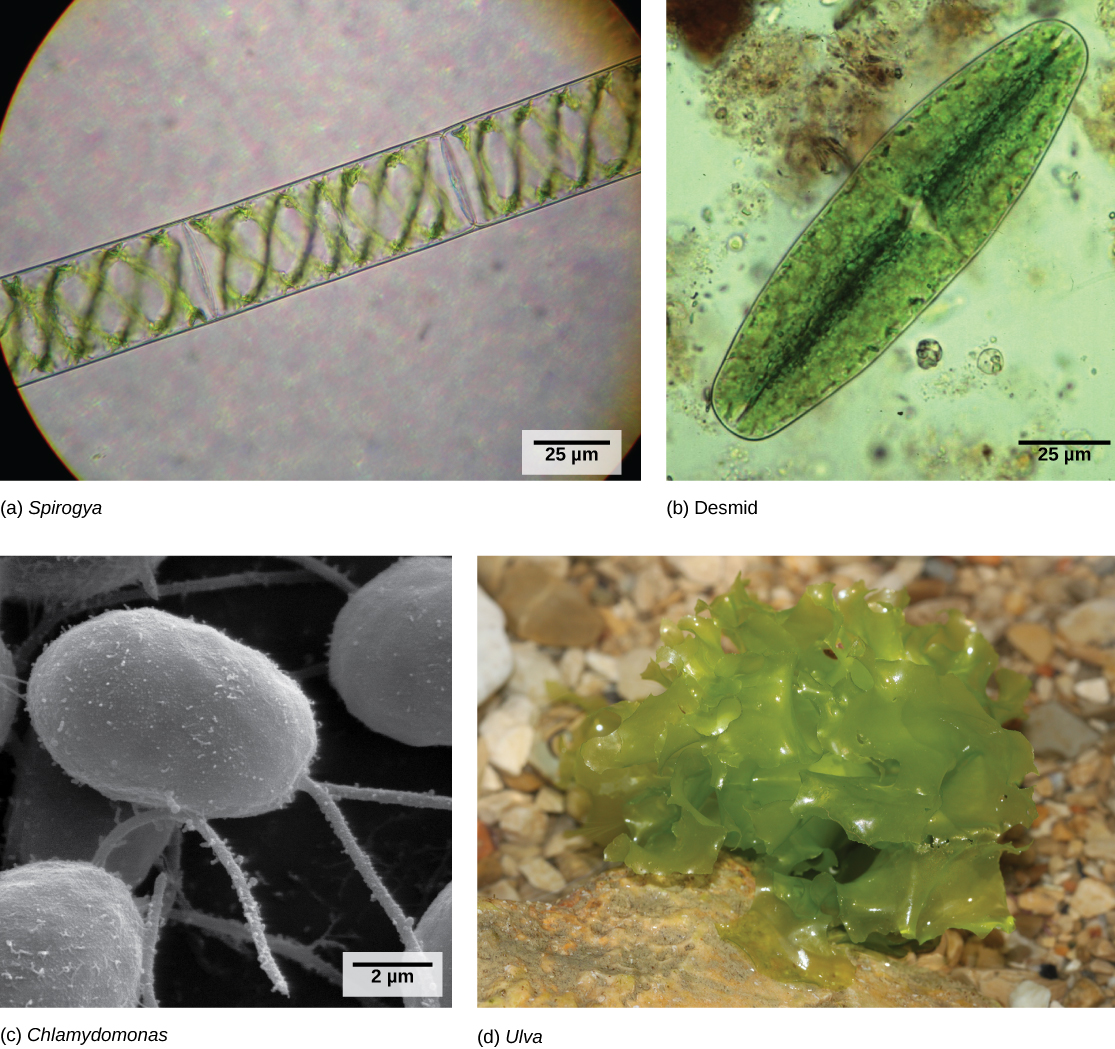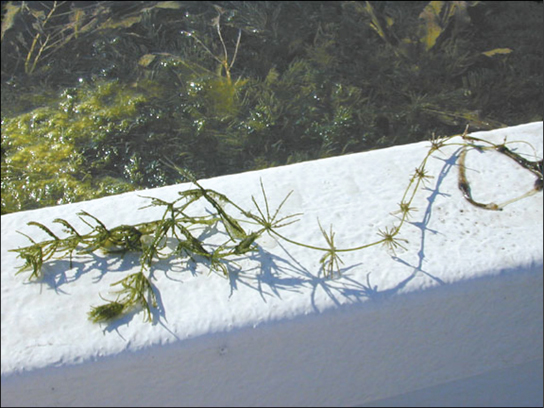How Does This Change When We Go From Chara To The Land Plants
Seedless Plants
128 Light-green Algae: Precursors of State Plants
Learning Objectives
Past the end of this department, you lot volition be able to practice the following:
- Describe the traits shared by light-green algae and land plants
- Explain why charophytes are considered the closest algal relative to land plants
- Explicate how current phylogenetic relationships are reshaped by comparative assay of Deoxyribonucleic acid sequences
Streptophytes
Until recently, all photosynthetic eukaryotes were classified as members of the kingdom Plantae. The brownish and golden algae, even so, are now reassigned to the protist supergroup Chromalveolata. This is because apart from their power to capture lite energy and fix CO2, they lack many structural and biochemical traits that are feature of plants. The plants are now classified, along with the red and green algae, in the protist supergroup Archaeplastida. Light-green algae contain the same carotenoids and chlorophyll a and b as land plants, whereas other algae have different accessory pigments and types of chlorophyll molecules in addition to chlorophyll a. Both green algae and land plants also store carbohydrates as starch. Their cells contain chloroplasts that display a boundless diversity of shapes, and their cell walls contain cellulose, every bit do country plants. Which of the green algae to include among the plants has not been phylogenetically resolved.
Green algae fall into two major groups, the chlorophytes and the charophytes. The chlorophytes include the genera Chlorella, Chlamydomonas, the "sea lettuce" Ulva, and the colonial alga Volvox. The charophytes include desmids, also as the genera Spirogyra, Coleochaete, and Chara. There are familiar green algae in both groups. Some dark-green algae are single cells, such as Chlamydomonas and desmids, which adds to the ambivalence of green algae classification, because plants are multicellular. Other green algae, like Volvox, course colonies, and some, like Ulva are multicellular ((Figure)). Spirogyra is a long filament of colonial cells. About members of this genus live in fresh water, stagnant h2o, seawater, or even in snow patches. A few dark-green algae can survive on soil, provided it is covered by a thin film of moisture within which they can live. Periodic dry spells provide a selective advantage to algae that can survive water stress.
Green algae. Charophyta include (a) Spirogyra and (b) desmids. Chlorophyta include (c) Chlamydomonas, and (d) Ulva. Desmids and Chlamydomonas are single-celled organisms, Spirogyra forms chains of cells, and Ulva forms multicellular structures resembling leaves, although the cells are non differentiated equally they are in higher plants (credit b: modification of work by Derek Keats; credit c: modification of work by Dartmouth Electron Microscope Facility, Dartmouth College; credit d: modification of work past Holger Krisp; scale-bar data from Matt Russell)

The chlorophytes and the charophytes differ in a few respects that, in add-on to molecular analysis, place the land plants equally a sis group of the charophytes. Showtime, cells in charophytes and the land plants divide along cell plates called phragmoplasts, in which microtubules parallel to the spindle serve as guides for the vesicles of the forming cell plate. In the chlorophytes, the cell plate is organized by a phycoplast, in which the microtubules are perpendicular to the spindle. 2d, only the charophytes and the state plants take plasmodesmata, or intercellular channels that let the transfer of materials from cell to prison cell. In the chlorophytes, intercellular connections do not persist in mature multicellular forms. Finally, both charophytes and the state plants evidence apical growth—growth from the tips of the plant rather than throughout the found body. Consequently, country plants and the charophytes are now function of a new monophyletic grouping chosen Streptophyta.
Reproduction of Green Algae
Green algae reproduce both asexually, past fragmentation or dispersal of spores, or sexually, by producing gametes that fuse during fertilization. In a single-celled organism such as Chlamydomonas, there is no mitosis after fertilization. In the multicellular Ulva, a sporophyte grows by mitosis after fertilization (and thus exhibits alternation of generations). Both Chlamydomonas and Ulva produce flagellated gametes.
Charophytes
The charophytes include several unlike algal orders that accept each been suggested to exist the closest relatives of the state plants: the Charales, the Zygnematales, and the Coleochaetales. The Charales tin can exist traced dorsum 420 1000000 years. They live in a range of freshwater habitats and vary in size from a few millimeters to a meter in length. The representative genus is Chara ((Effigy)), oft called muskgrass or skunkweed because of its unpleasant odour. Big cells form the thallus: the main stalk of the alga. Branches arising from the nodes are fabricated of smaller cells. Male person and female person reproductive structures are plant on the nodes, and the sperm have flagella. Although Chara looks superficially like some land plants, a major difference is that the stem has no supportive tissue. However, the Charales exhibit a number of traits that are significant for accommodation to land life. They produce the compounds lignin and sporopollenin, and form plasmodesmata that connect the cytoplasm of side by side cells. Although the life cycle of the Charales is haplontic (the principal form is haploid, and diploid zygotes are formed but accept a brief existence), the egg, and later, the zygote, form in a protected chamber on the haploid parent found.
Chara. The representative alga, Chara, is a noxious weed in Florida, where information technology clogs waterways. (credit: Due south Florida Information Access, U.S. Geological Survey)

The Coleochaetes are branched or disclike multicellular forms. They can produce both sexually and asexually, but the life wheel is basically haplontic. Recent all-encompassing DNA sequence analysis of charophytes indicates that the Zygnematales are more closely related to the embryophytes than the Charales or the Coleochaetales. The Zygnematales include the familiar genus Spirogyra, as well as the desmids. As techniques in Deoxyribonucleic acid analysis improve and new information on comparative genomics arises, the phylogenetic connections between the charophytes and the country plants will connected to be examined to produce a satisfactory solution to the mystery of the origin of country plants.
Section Summary
Charophytes share more traits with land plants than practise other algae, co-ordinate to structural features and DNA analysis. Within the charophytes, the Charales, the Coleochaetales, and the Zygnematales have been each considered as sharing the closest common ancestry with the land plants. Charophytes form sporopollenin and precursors of lignin, phragmoplasts, and have flagellated sperm. They do not exhibit alternation of generations.
Review Questions
What feature of Charales would enable them to survive a dry out spell?
- sperm with flagella
- phragmoplasts
- sporopollenin
- chlorophyll a
C
Which one of these characteristics is nowadays in country plants and not in Charales?
- alternation of generations
- flagellated sperm
- phragmoplasts
- plasmodesmata
A
A scientist sequences the genome of Chara, red algae, and a tomato plant. What result would support the conclusion that Charophytes should be included in the Plantae kingdom?
- The Chara genome is more than similar to the ruddy algae than the tomato found.
- All iii genomes are distinctly different.
- The Chara genome is more similar to the tomato found genome than the ruddy algae genome.
- The tomato plant plant genome is distinct from the reddish algae genome.
C
Which of the following features does non support the inclusion of Charophytes in the Plantae kingdom?
- Charophyte chloroplasts contain chlorophyll a and b.
- Charophyte constitute cell walls contain plasmodesmata to allow transfer between cells within multicellular organisms.
- Charophytes exercise not exhibit growth throughout the entire constitute torso.
- Charophytes are multicellular organisms that lack vascular tissue.
D
Disquisitional Thinking Questions
To an alga, what is the main advantage of producing drought-resistant structures?
It allows for survival through periodic droughts and colonization of environments where the supply of h2o fluctuates.
Glossary
- streptophytes
- group that includes dark-green algae and land plants
Source: https://opentextbc.ca/biology2eopenstax/chapter/green-algae-precursors-of-land-plants/
Posted by: knighteassom.blogspot.com


0 Response to "How Does This Change When We Go From Chara To The Land Plants"
Post a Comment